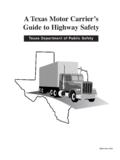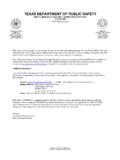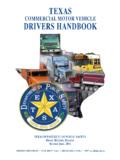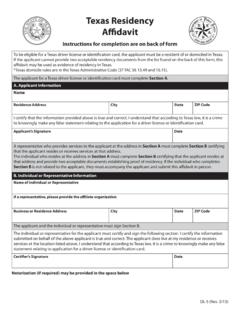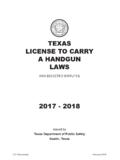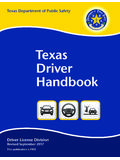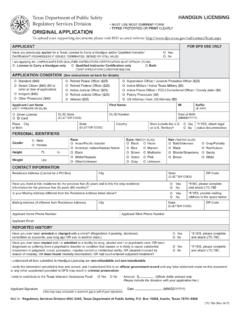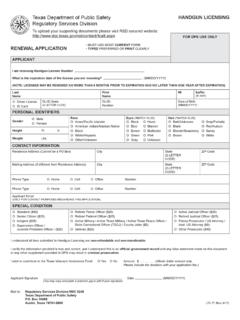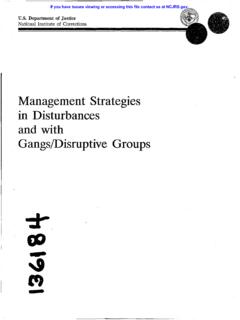Transcription of UNCLASSIFIED Texas
1 Texas DEPARTMENT OF PUBLIC SAFETY Texas UNCLASSIFIED November 2018 gang Threat Assessment UNCLASSIFIED UNCLASSIFIED UNCLASSIFIED 1 THIS PAGE INTENTIONALLY LEFT BLANK UNCLASSIFIED UNCLASSIFIED 2 Texas gang Threat Assessment A Sta te Intelli gence Estimate Produced by the Texas Joint Crime Information center Intelligence & Counterte rror ism Division Texas Dep artment of Public Safety In collaboration with federal, state, and local law enforcement and criminal justice agencies November 2018 UNCLASSIFIED UNCLASSIFIED 3 THIS PAGE INTENTIONALLY LEFT BLANK UNCLASSIFIED UNCLASSIFIED 4 (U) Executive Summary (U) The key analytic judgments of this assessment are: (U) Gangs are a significant threat to public safety in Texas .
2 Texas gangs are responsible for high levels of violence throughout the state, such as murder, sex trafficking, armed robbery, and aggravated assault. Texas gangs are heavily involved in the trafficking of methamphetamine, heroin, cocaine, and marijuana, and will often work with each other regardless of race or ideology in order to profit from the trafficking of drugs. We assess there are more than 100,000 gang members in Texas at any given time based on available information and data from multiple sources. (U) Gangs in Texas continue to work closely with the Mexican cartels.
3 Gangs provide direct support to cartel drug and human smuggling operations into and throughout Texas and the nation. Cartels also utilize gang members to procure and move weapons and money to Mexico, and sometimes to commit violent crimes on both sides of the border. Given the entrenched connections between gangs and cartels for drug distribution, we are concerned about the role gangs could play in trafficking fentanyl and contributing to the national opioid epidemic. As long as illicit cross-border crimes are profitable, the relationship between cartels and Texas gangs will continue.
4 (U) Gangs assessed with a Tier 1 ranking pose the greatest gang threat to the state. This assessment is based on several factors, including involvement in drug and human smuggling, sex trafficking, transnational criminal activity, level of violence, and overall statewide strength and presence. The tier rankings represent the threat posed by various gangs on a statewide level and do not necessarily represent the greatest gang threat in any particular city, county, or region. For example, a Tier 3 gang could be a significant public safety threat in a particular community because of their involvement in drug distribution, sex trafficking of children, and takeover robberies.
5 The Tier 1 gangs are: Tango Blast and associated Tango cliques (Estimated 22,000-25,000 members) Texas Mexican Mafia (Estimated 4,000-6,000 members) Mara Salvatrucha (MS-13) (Estimated 600-1,000 members) Barrio Azteca (Estimated 1,000-2,500 members) (U) Some members within traditional gangs, such as Texas Syndicate and Texas Mexican Mafia, operate independently of the gang . Continuous and successful law enforcement operations targeting traditionally organized gangs have resulted in some members working outside of the gang . In addition, some members are reluctant to take on leadership roles in order to avoid criminal enterprise investigations and prosecutions.
6 (U) Younger gang members are relinquishing traditional gang structure and rules, opting for less organizational oversight and the freedom to serve in self-interested roles. The new generation of gang members prefer a free enterprise, no-oversight approach to their criminal operations, as seen in gangs such as Tango Blast. Previously, many Texas gangs operated under a strict rule of blood in, blood out, which mandated members to remain in the gang for life or face punishment. Now younger gang members are committing crimes in order to enjoy the profits for themselves, without first receiving permission from gang leadership.
7 (U) Motorcycle gangs continue to challenge the dominance of the Bandidos Outlaw Motorcycle gang (OMG) in Texas . The aftermath of the deadly Waco incident involving the Bandidos on May 17, 2015, along with the arrests and convictions of the Bandidos national leadership, provides UNCLASSIFIED UNCLASSIFIED 5 opportunities for OMGs, such as the Mongols, to operate and claim Texas as territory. Disgruntled Bandidos members in Texas created a rival motorcycle gang called the Kinfolk, which led to violent conflicts around the state. (U) Gangs use social media to communicate, boast, and recruit.
8 gang members of all ages use social media and video-sharing websites to brag, recruit, promote, and antagonize. They also utilize encrypted mobile messaging applications to communicate privately to thwart law enforcement s ability to counter their criminal activities. UNCLASSIFIED UNCLASSIFIED 6 (U) Table of Contents (U) Title Page .. 2 (U) Executive Summary .. 4 (U) Table of Contents .. 6 (U) Acknowledgments .. 8 (U) Preface .. 10 (U) State Intelligence Estimates .. 12 (U) Introduction .. 14 (U) Prioritization and Criteria.
9 16 (U) MS-13 Remains a Tier 1 Threat .. 19 (U) The Return of Barrio Azteca as a Tier 1 Threat .. 20 (U) Law Enforcement 22 (U) gang Encounters During Operations North Star & Alamo .. 27 (U) Regional Assessments .. 28 (U) gang Involvement in Scouting for Smuggling Operations in South Texas .. 35 (U) gang Organization .. 36 (U) gang Relationships .. 38 (U) Offense Types for gang Members in Texas Prisons .. 40 (U) gang Involvement in Sex Trafficking .. 41 (U) Outlook .. 42 (U) Appendix 1: Overview of Tier 1 and Tier 2 Gangs .. 44 (U) Appendix 2: Other Contributing Agencies.
10 54 (U) References .. 60 UNCLASSIFIED UNCLASSIFIED 7 THIS PAGE INTENTIONALLY LEFT BLANK UNCLASSIFIED UNCLASSIFIED 8 (U) Acknowledgments (U) The Texas Joint Crime Information center collaborated with law enforcement and criminal justice agencies across Texas and the United States in the production of this State Intelligence Estimate. Their contributions were invaluable in developing a comprehensive assessment of the threat posed by gangs in Texas , and they underscore the commitment among law enforcement and criminal justice agencies in Texas to share information and intelli gence in order to effec tivel y combat crime and improve public safety.
